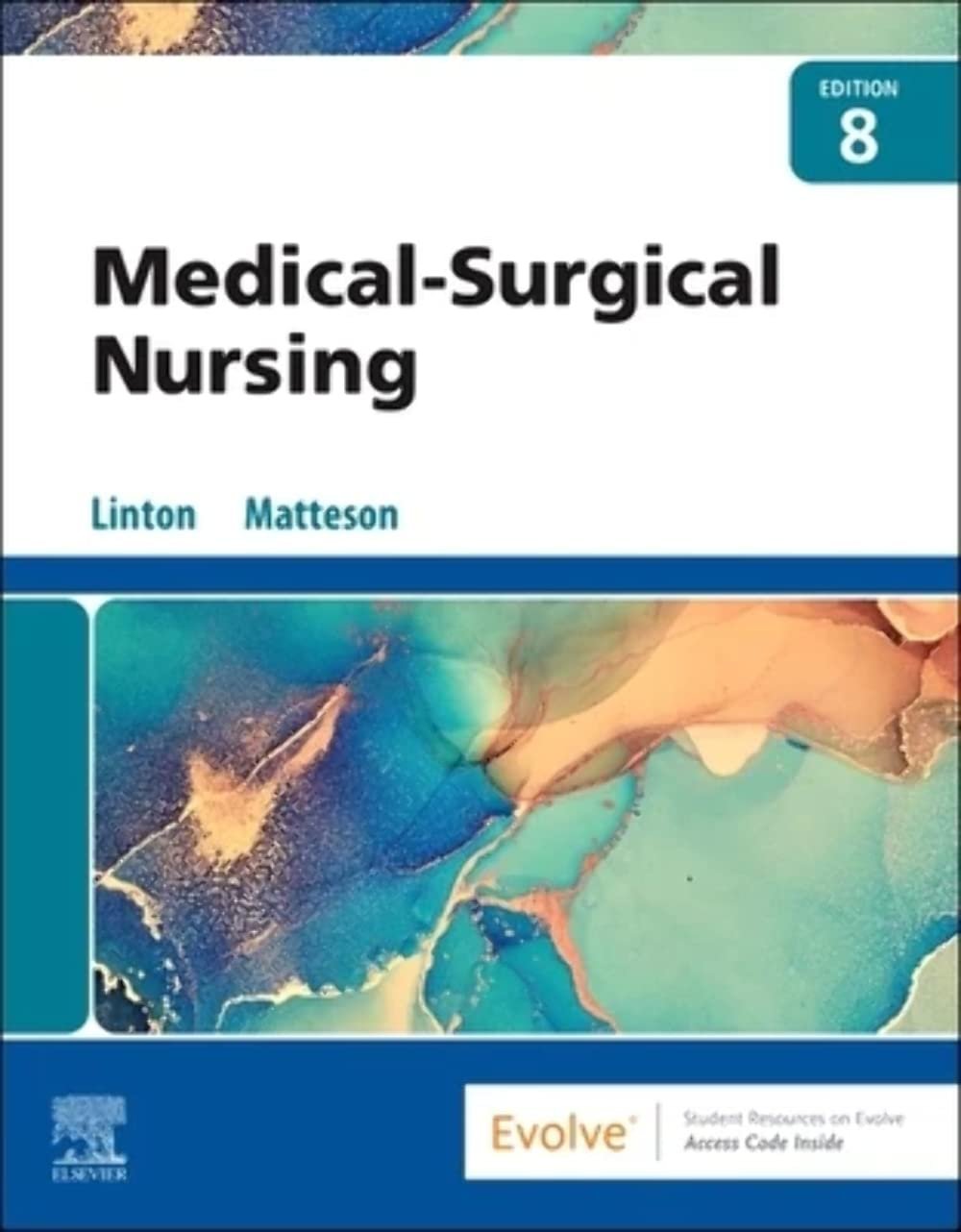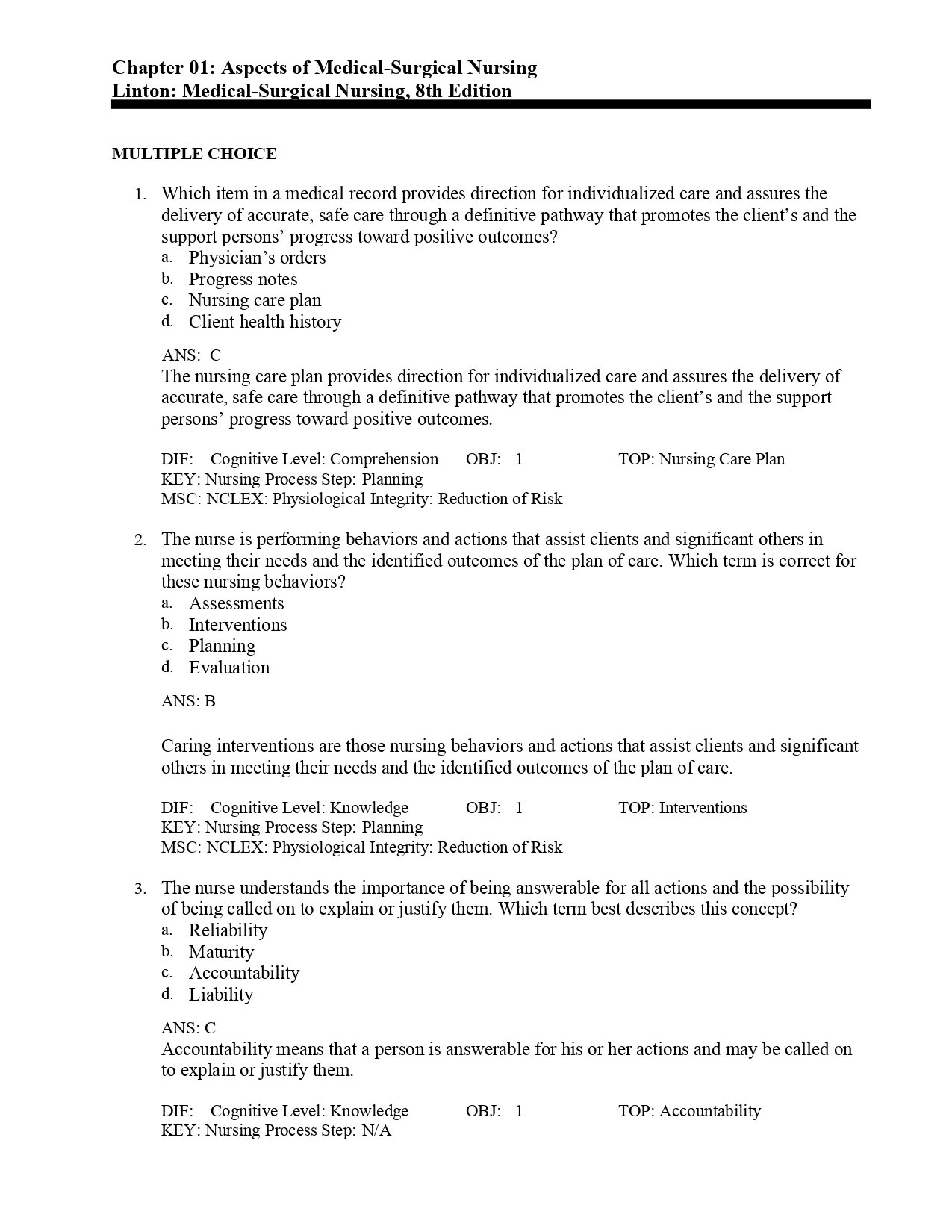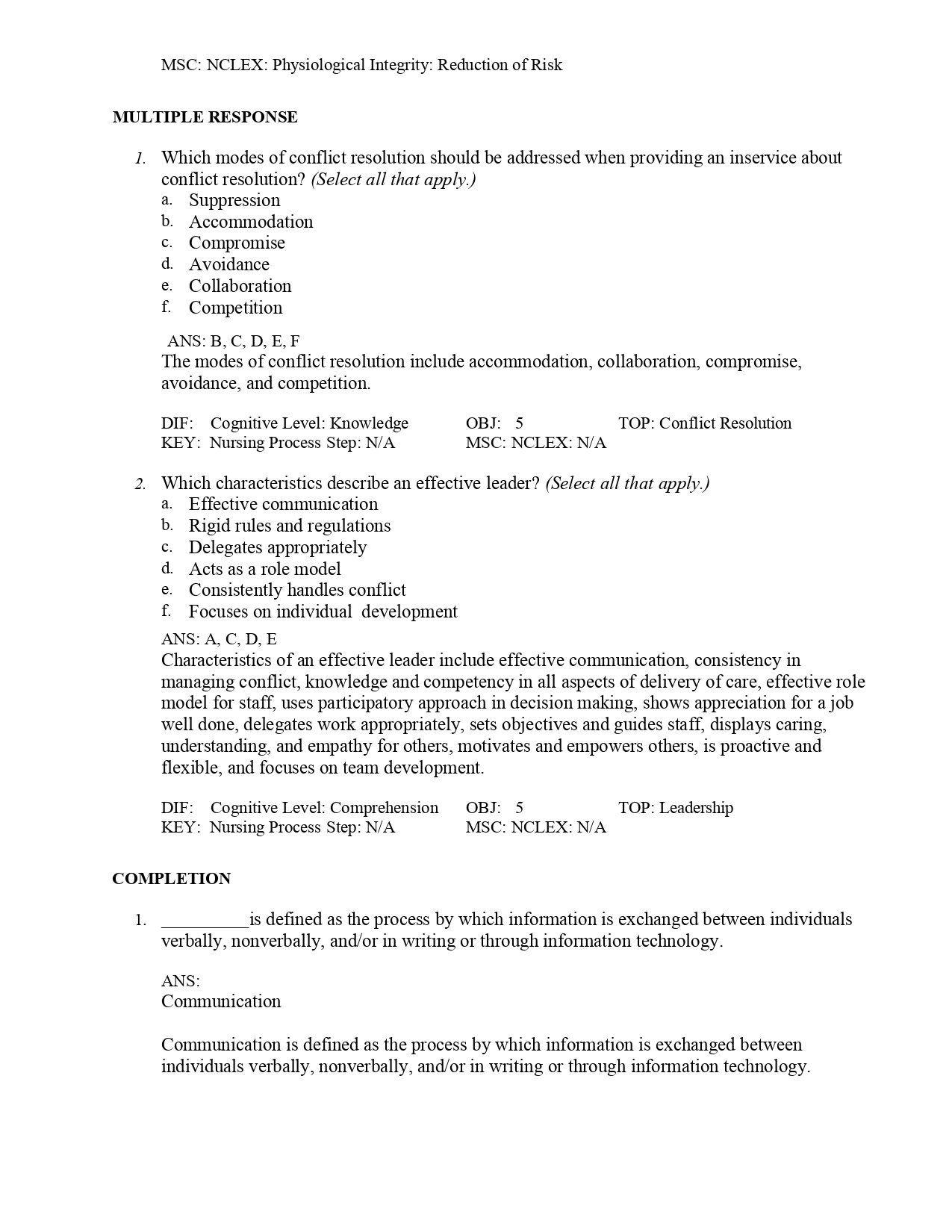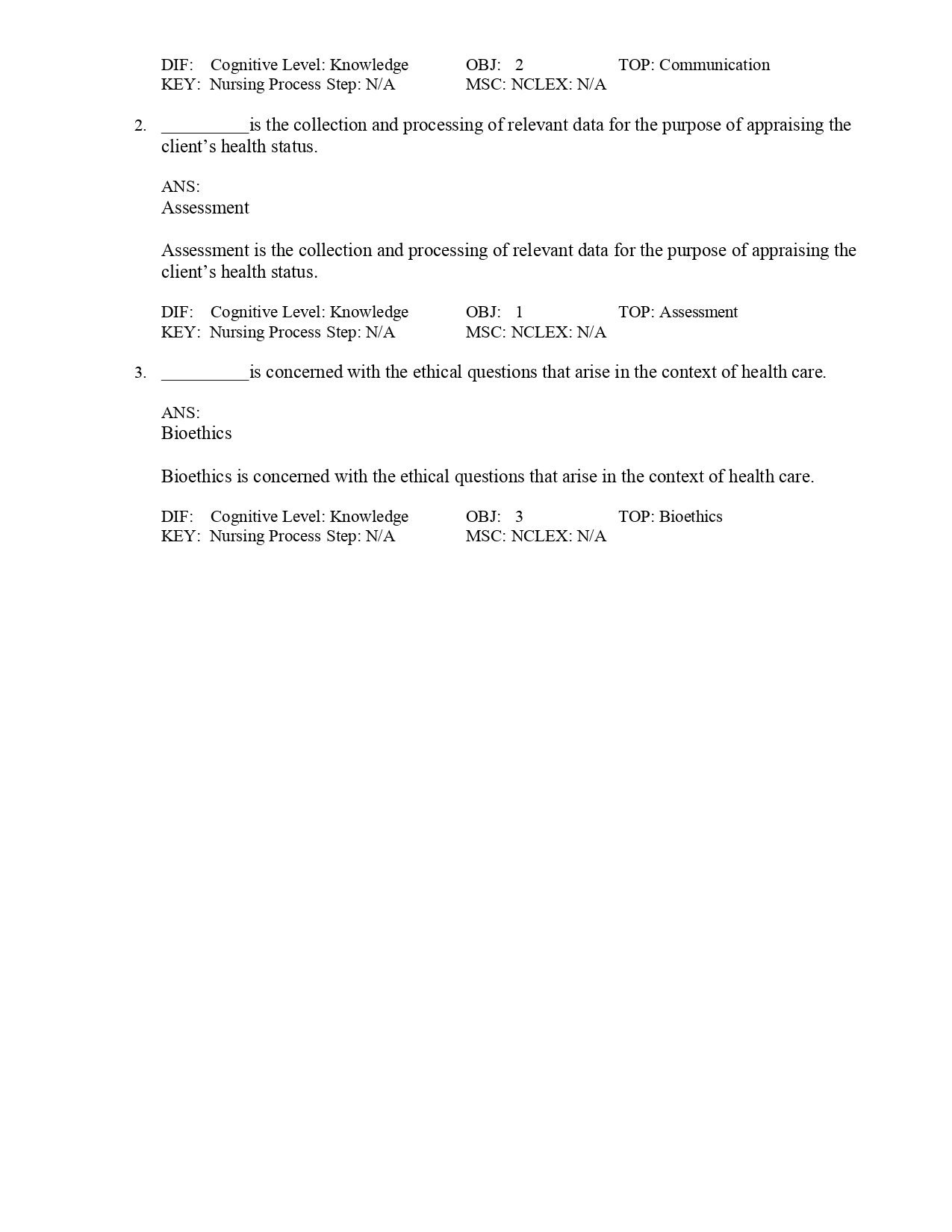Test Bank for Medical-Surgical Nursing: Concepts and Practice, 8th Edition
$26.00 Original price was: $26.00.$23.00Current price is: $23.00.
Instant PDF Download — Access right after checkout. The Medical-Surgical Nursing: Concepts and Practice, 8th Edition Test Bank by Adrianne Dill Linton delivers chapter-organized NCLEX®/HESI®/ATI-style questions with verified answers and detailed rationales. Ideal for RN/PN/BSN med-surg courses and exam prep.
- Covers all 63 chapters from Linton 8e
- MCQs + clinical judgment items with rationales
- Searchable, printable PDF for any device

Description
Download the Test Bank for Medical-Surgical Nursing: Concepts and Practice, 8th Edition by Adrianne Dill Linton (PDF) — the ultimate resource for nursing students preparing for NCLEX®, HESI®, and ATI exams. This comprehensive digital test bank aligns perfectly with Linton’s 8th Edition textbook and covers every core concept in adult health and medical-surgical nursing.
Inside, you’ll find chapter-organised multiple-choice questions, alternate-format items, and detailed answer rationales designed to strengthen clinical reasoning and test-taking confidence. Each question mirrors real exam scenarios across critical topics like fluid and electrolyte balance, cardiovascular care, respiratory disorders, endocrine management, perioperative nursing, and patient safety.
Whether you’re an RN, LPN/LVN, or BSN student, this verified Linton 8th Edition test bank helps you master the nursing process, evidence-based practice, and NCLEX-style prioritisation questions. Instructors can also use it to create accurate, ready-to-use quizzes and comprehensive assessments for classroom or online courses.
Key features:
- Instant digital PDF download – compatible with all devices (laptop, tablet, mobile).
- Includes answers with rationales for every question.
- Follows the official Linton 8th Edition textbook chapter sequence.
- Ideal for NCLEX®, HESI®, ATI®, and Med-Surg Nursing course review.
- Structured for both self-study and instructor use.
Start studying smarter today with the Medical-Surgical Nursing 8th Edition Test Bank — your trusted, evidence-based companion for clinical success and exam mastery.
Table of Contents
Chapter 01: Aspects of Medical-Surgical Nursing
Chapter 02: Medical-Surgical Practice Settings
Chapter 03: Medical-Surgical Patients: Individuals, Families, and Communities1
Chapter 04: Health, Illness, Stress, and Coping
Chapter 05: Immunity, Inflammation, and Infection
Chapter 06: Fluid, Electrolyte, and Acid–Base Balance
Chapter 07: The Patient With Cancer
Chapter 08: Pain
Chapter 09: Shock
Chapter 10: The Older Adult Patient
Chapter 11: Falls
Chapter 12: Immobility
Chapter 13: Delirium and Dementia
Chapter 14: Incontinence
Chapter 15: Nutrition
Chapter 16: Intravenous Therapy
Chapter 17: Surgery
Chapter 18: The Patient With an Ostomy
Chapter 19: Palliative and Hospice Care
Chapter 20: Complementary and Alternative Therapies and Integrative Health Care
Chapter 21: Neurological System Introduction
Chapter 22: Neurological Disorders
Chapter 23: Cerebrovascular Accident
Chapter 24: Spinal Cord Injury
Chapter 25: Respiratory System Introduction
Chapter 26: Upper Respiratory Disorders
Chapter 27: Acute Lower Respiratory Disorders
Chapter 28: Chronic Lower Respiratory Tract Disorders
Chapter 29: Hematologic System Introduction
Chapter 30: Hematologic Disorders
Chapter 31: Immunologic System Introduction
Chapter 32: Immunologic Disorders
Chapter 33: Cardiovascular System Introduction
Chapter 34: Hypertension
Chapter 35: Cardiac Disorders
Chapter 36: Vascular Disorders
Chapter 37: Digestive System Introduction
Chapter 38: Upper Digestive Tract Disorders
Chapter 39: Lower Digestive Tract Disorders
Chapter 40: Liver, Gallbladder, and Pancreatic Disorders
Chapter 41: Urologic System Introduction
Chapter 42: Urologic Disorders
Chapter 43: Musculoskeletal System Introduction
Chapter 44: Connective Tissue Disorders
Chapter 45: Fractures
Chapter 46: Amputations
Chapter 47: Endocrine System Introduction
Chapter 48: Pituitary and Adrenal Disorders
Chapter 49: Thyroid and Parathyroid Disorders
Chapter 50: Diabetes and Hypoglycemia
Chapter 51: Female Reproductive System Introduction
Chapter 52: Female Reproductive Disorders
Chapter 53: Male Reproductive System Introduction
Chapter 54: Male Reproductive Disorders
Chapter 55: Sexually Transmitted Infections
Chapter 56: Integumentary System Introduction
Chapter 57: Skin Disorder
Chapter 58: Special Senses: Vision and Hearing Introduction
Chapter 59: Eye and Vision Disorders
Chapter 60: Ear and Hearing Disorders
Chapter 61: Psychobiologic Disorders
Chapter 62: Substance-Related and Addictive Disorders
Chapter 63: First Aid, Emergency Care, and Disaster Management
Sample Questions — Chapter 01: Aspects of Medical-Surgical Nursing
Linton: Medical-Surgical Nursing, 8th Edition
MULTIPLE CHOICE
1. Which item in a medical record provides direction for individualized care and assures the delivery of accurate, safe care through a definitive pathway that promotes the client’s and the
support persons’ progress toward positive outcomes?
a. Physician’s orders
b. Progress notes
c. Nursing care plan
d. Client health history
ANS: C
The nursing care plan provides direction for individualized care and assures the delivery of accurate, safe care through a definitive pathway that promotes the client’s and the support
persons’ progress toward positive outcomes.
DIF: Cognitive Level: Comprehension OBJ: 1 TOP: Nursing Care Plan
KEY: Nursing Process Step: Planning
MSC: NCLEX: Physiological Integrity: Reduction of Risk
2. The nurse is performing behaviors and actions that assist clients and significant others in meeting their needs and the identified outcomes of the plan of care. Which term is correct for
these nursing behaviors?
a. Assessments
b. Interventions
c. Planning
d. Evaluation
ANS: B
Caring interventions are those nursing behaviors and actions that assist clients and significant others in meeting their needs and the identified outcomes of the plan of care.
DIF: Cognitive Level: Knowledge OBJ: 1 TOP: Interventions
KEY: Nursing Process Step: Planning
MSC: NCLEX: Physiological Integrity: Reduction of Risk
3. The nurse understands the importance of being answerable for all actions and the possibility of being called on to explain or justify them. Which term best describes this concept?
a. Reliability
b. Maturity
c. Accountability
d. Liability
ANS: C
Accountability means that a person is answerable for his or her actions and may be called on to explain or justify them.
DIF: Cognitive Level: Knowledge OBJ: 1 TOP: Accountability
KEY: Nursing Process Step: N/AMSC: NCLEX: Physiological Integrity: Reduction of Risk
Medical-Surgical Nursing 8th Edition — FAQs
1) What’s included in the Medical-Surgical Nursing 8th Edition Test Bank (PDF)?
This Adrianne Dill Linton Med-Surg Test Bank includes over 60 chapters of NCLEX®, HESI®, and ATI-style multiple-choice questions with verified answers and concise rationales. Topics cover cardiac, respiratory, endocrine, renal, neuro, oncology, and perioperative nursing — all mapped to the official Medical-Surgical Nursing: Concepts and Practice, 8th Edition textbook.
2) Does this test bank match the official Linton 8th Edition textbook?
Yes — this test bank follows the exact chapter order and learning objectives of Linton’s 8th Edition. You can easily use it alongside your course materials, PowerPoints, or eTextbook without re-ordering content.
3) How will I receive my Med-Surg Nursing test bank after purchase?
Once payment is complete, you’ll receive an instant PDF download link. The file is compatible with laptops, tablets, and mobile devices, and can be printed or searched digitally for easy study access anywhere.
4) Do the questions include answers and explanations?
Absolutely. Each question includes a correct answer with a detailed rationale — helping you understand why each option is right or wrong and improving your clinical judgment and test-taking confidence.
5) Who is this Linton 8e Medical-Surgical Test Bank designed for?
This resource is perfect for nursing students in RN, PN, or BSN programs, as well as instructors preparing unit exams or NCLEX® review sessions. It’s also suitable for HESI® and ATI® exam prep focused on medical-surgical concepts and clinical reasoning.
Related products
-
Sale!
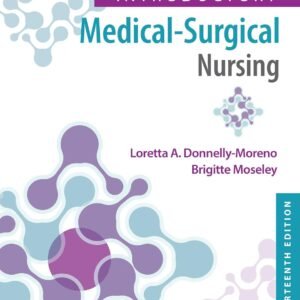
Test Bank for Timby’s Introductory Medical-Surgical Nursing, 13th Edition by Loretta A. Donnelly-Moreno & Brigitte Moseley
$26.00Original price was: $26.00.$23.00Current price is: $23.00. Add to cart -
Sale!

Test Bank for Community/Public Health Nursing: Promoting the Health of Populations, 8th Edition
$26.00Original price was: $26.00.$23.00Current price is: $23.00. Add to cart -

Test bank for Davis Advantage for Townsend’s Essentials of Psychiatric Mental Health Nursing 9th Edition
$23.00 Add to cart -
Sale!

Test Bank for Davis Advantage for Basic Nursing: Thinking, Doing, and Caring, 3rd Edition by Leslie S. Treas, Karen L. Barnett & Mable H. Smith
$26.00Original price was: $26.00.$23.00Current price is: $23.00. Add to cart

